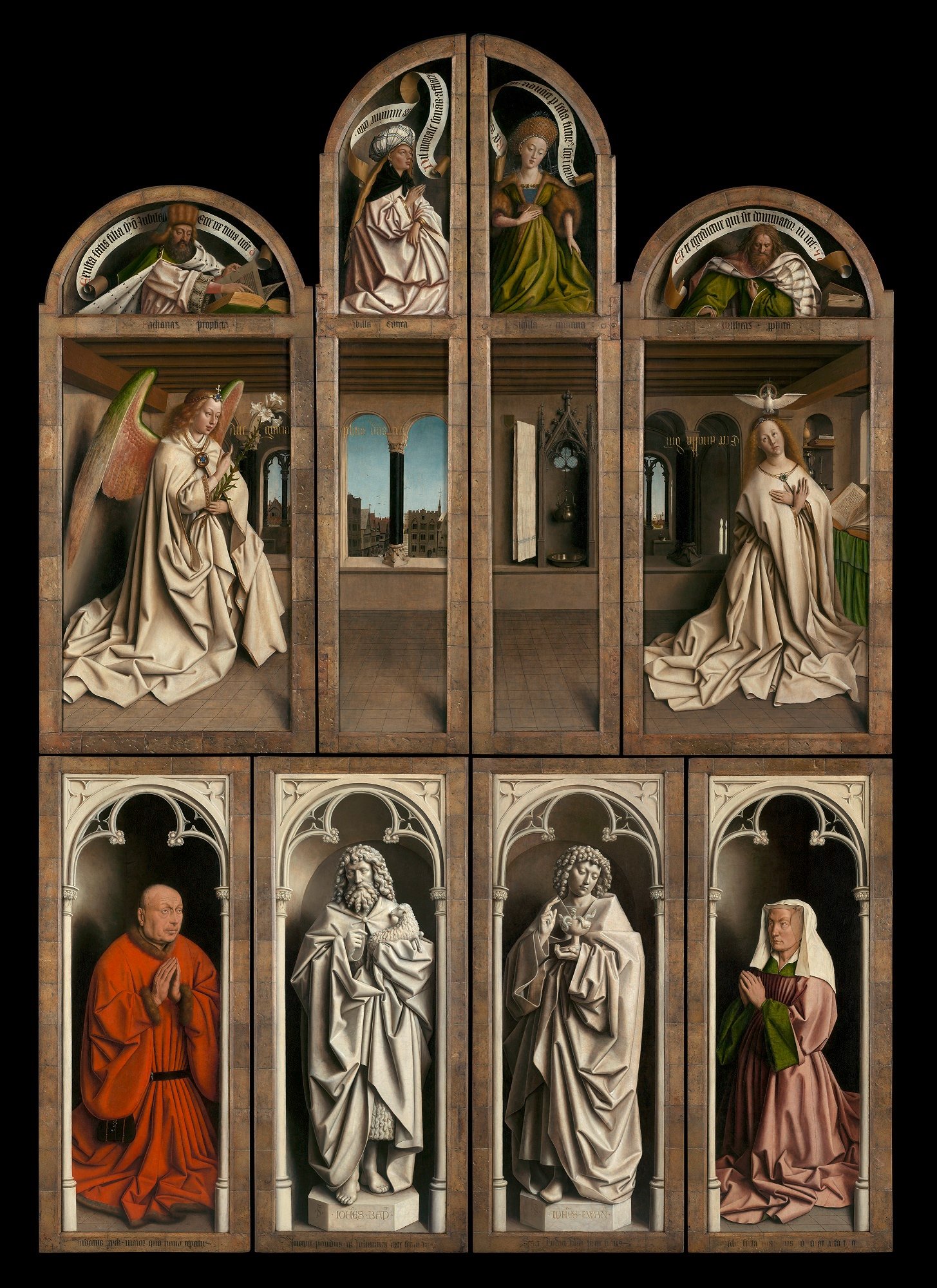
Around half of the known works by Flemish master Jan van Eyck will be exhibited in a once-in-a-lifetime exhibition in Belgium next week alongside the newly restored Ghent Altarpiece, one of the most famous—and most stolen—works of art in the world.
Van Eyck’s precise, virtuoso paintings have captivated historians and artists alike for centuries. In a 2007 interview, painter Luc Tuymans said: “After the Flemish primitives, and foremost among them Jan van Eyck, any artist can only be a dilettante.”
And as it turns out, there are new revelations still to be discovered in Van Eyck’s oeuvre, more than 500 years after his death. The exhibition, which opens February 1 at the Museum of Fine Arts Ghent, brings together more of the artist’s works than have ever been seen in one place. It’s a highlight of the Belgian city’s Year of Van Eyck, timed to coincide with the completion of the ambitious six-year, $2.5 million restoration of Hubert and Jan van Eyck’s masterpiece, the Ghent Altarpiece.
High-tech, extensive conservation has revealed striking new details, like the surprisingly humanoid face on the sacrificial lamb representing Christ and buildings that reflect the architecture of medieval Ghent. (The lamb’s newly intensely gaze has already caused a stir online.) All eight of the restored outer panels will go on view for the first—and likely the last—time at the museum; the altarpiece is almost never shown outside of its home at Saint Bavo’s Cathedral in Ghent. The public seems to have recognized the importance of the occasion: 40,000 tickets have already been sold.
In addition to 12 works by Van Eyck and nine from his studio, more than 100 works by his contemporaries, including the early Italian Renaissance artists Fra Angelico, Pisanello, and Stefano de Giovanni, will also be included in the show, alongside a remarkable collection of miniatures painted in medieval illuminated manuscripts.
Jan van Eyck and workshop, The Madonna at the fountain (c. 1440). Private collection. Courtesy of the Frick Collection.
The Ghent Altarpiece, also known as The Adoration of the Mystic Lamb, has an eventful history. It has been dismantled and stolen six times over the centuries, including by Napoleon. Hitler wanted it for his mega-museum in Linz, Austria. The panels were finally reunited after World War II—although one piece depicting righteous judges, which was stolen in 1934, remains missing to this day.
The interior panels of the altarpiece are staying put in the Belgian city’s cathedral and will be reunited with the external ones in the cathedral’s new visitor center once the museum exhibition closes at the end of April. New displays in the center include an augmented-reality experience explaining the work’s religious and art historical significance.
The landmark exhibition has been put together with major loans from collections around the world, including the Metropolitan Museum of Art in New York, the J. Paul Getty Museum in Los Angeles, the Prado in Madrid, and the Vatican Museums. London’s National Gallery agreed to loan of the mysterious Portrait of a Man (Léal souvenir), one of its three works by Van Eyck, which was completed the same year the altarpiece was finished.
Jan van Eyck, Saint Francis of Assisi Receiving the Stigmata (around 1430-1432). Philadelphia Museum of Art, John G. Johnson Collection, 1917 Courtesy of the Philadelphia Museum of Art.
The festivities are all a part of Ghent’s year of Van Eyck, which will include other exhibitions and themed events. Belgium’s Royal Institute for Cultural Heritage has announced the completion of the astonishing task of fully digitizing Van Eyck’s complete painted works and miniatures to coincide with the celebrations. The works are available online in high resolution at the Closer to Van Eyck website. The digitized collection is due to be exhibited at Brussels’s BOZAR – Centre for Fine Arts in September.
See more works from the remarkable exhibition below.
“Van Eyck. An Optical Revolution” runs February 1 through April 30 at the Museum of Fine Arts Ghent, Belgium.
Jan van Eyck, Portrait of a Man (Léal souvenir or Tymotheos) (1432). (Before restoration). The National Gallery, London. Copyright the National Gallery, London.
Jan van Eyck, Portrait of Baudouin de Lannoy (around 1435). Gemäldegalerie der Staatlichen Museen zu Berlin – Preussischer Kulturbesitz, Berlin. © KIK-IRPA, Brussel.
Jan van Eyck, Portrait of Jan de Leeuw (1436). Kunsthistorisches Museum Wenen, Gemäldegalerie.
Jan van Eyck, The Annunciation (around 1434-1436). National Gallery of Art, Washington, DC, Andrew W. Mellon Collection.
Barthélemy d’Eyck, The Virgin and Child Standing before a Cloth of Honor (around 1440-1450). The Morgan Library & Museum, New York.
Anonymous, Tapestry with Scenes from the Passion of Christ: Christ Carrying the Cross, The Crucifixion and The Resurrection (around 1445-1455). Royal Museums of Art and History of Belgium, Brussels
©KMKG, Brussels.
Benozzo Gozzoli, The Madonna with Child and Angels (around 1449-1450). Fondazione Accademia Carrara, Bergamo.